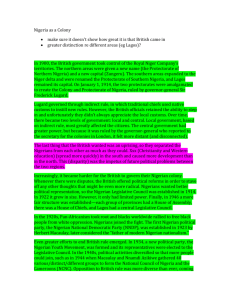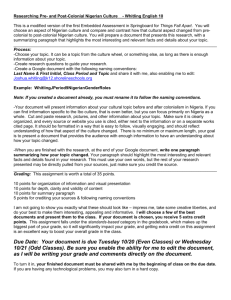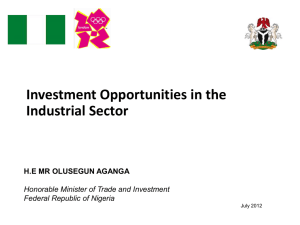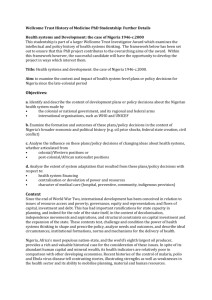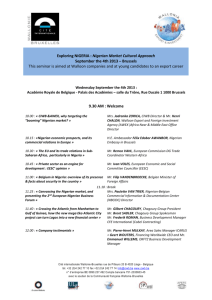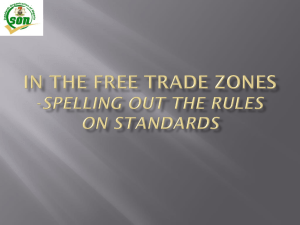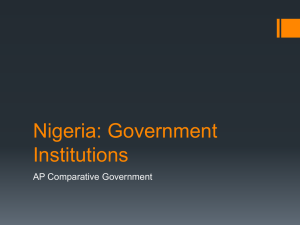“They Have Asked Us to Smile”: A Creative Treatise on the
advertisement
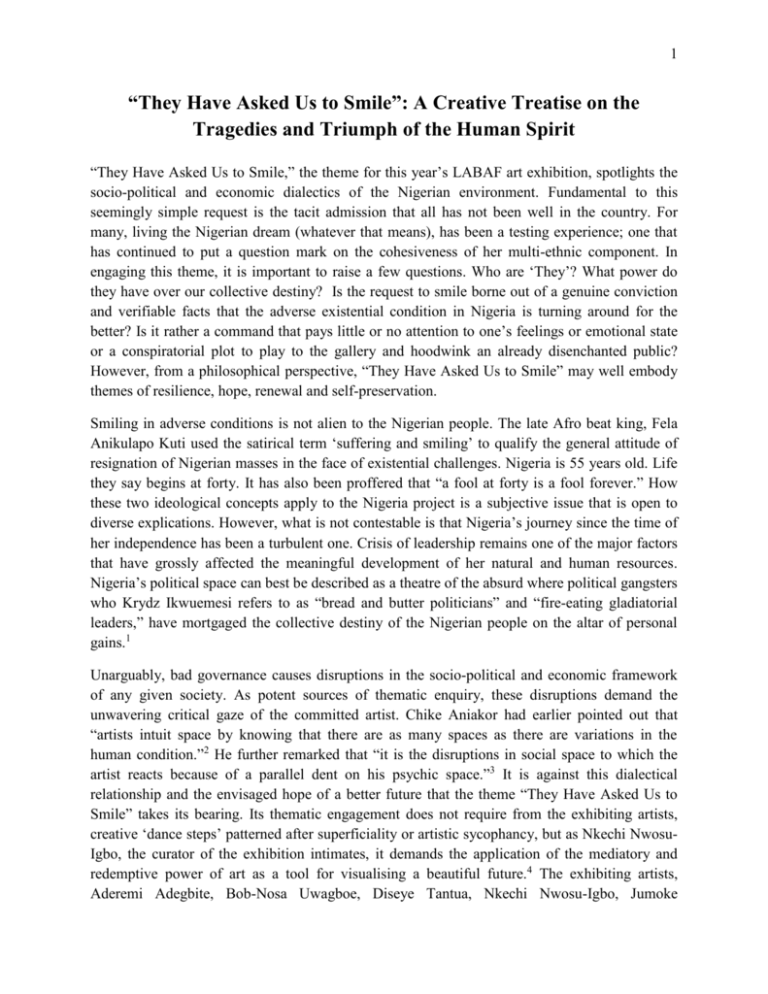
1 “They Have Asked Us to Smile”: A Creative Treatise on the Tragedies and Triumph of the Human Spirit “They Have Asked Us to Smile,” the theme for this year’s LABAF art exhibition, spotlights the socio-political and economic dialectics of the Nigerian environment. Fundamental to this seemingly simple request is the tacit admission that all has not been well in the country. For many, living the Nigerian dream (whatever that means), has been a testing experience; one that has continued to put a question mark on the cohesiveness of her multi-ethnic component. In engaging this theme, it is important to raise a few questions. Who are ‘They’? What power do they have over our collective destiny? Is the request to smile borne out of a genuine conviction and verifiable facts that the adverse existential condition in Nigeria is turning around for the better? Is it rather a command that pays little or no attention to one’s feelings or emotional state or a conspiratorial plot to play to the gallery and hoodwink an already disenchanted public? However, from a philosophical perspective, “They Have Asked Us to Smile” may well embody themes of resilience, hope, renewal and self-preservation. Smiling in adverse conditions is not alien to the Nigerian people. The late Afro beat king, Fela Anikulapo Kuti used the satirical term ‘suffering and smiling’ to qualify the general attitude of resignation of Nigerian masses in the face of existential challenges. Nigeria is 55 years old. Life they say begins at forty. It has also been proffered that “a fool at forty is a fool forever.” How these two ideological concepts apply to the Nigeria project is a subjective issue that is open to diverse explications. However, what is not contestable is that Nigeria’s journey since the time of her independence has been a turbulent one. Crisis of leadership remains one of the major factors that have grossly affected the meaningful development of her natural and human resources. Nigeria’s political space can best be described as a theatre of the absurd where political gangsters who Krydz Ikwuemesi refers to as “bread and butter politicians” and “fire-eating gladiatorial leaders,” have mortgaged the collective destiny of the Nigerian people on the altar of personal gains.1 Unarguably, bad governance causes disruptions in the socio-political and economic framework of any given society. As potent sources of thematic enquiry, these disruptions demand the unwavering critical gaze of the committed artist. Chike Aniakor had earlier pointed out that “artists intuit space by knowing that there are as many spaces as there are variations in the human condition.”2 He further remarked that “it is the disruptions in social space to which the artist reacts because of a parallel dent on his psychic space.”3 It is against this dialectical relationship and the envisaged hope of a better future that the theme “They Have Asked Us to Smile” takes its bearing. Its thematic engagement does not require from the exhibiting artists, creative ‘dance steps’ patterned after superficiality or artistic sycophancy, but as Nkechi NwosuIgbo, the curator of the exhibition intimates, it demands the application of the mediatory and redemptive power of art as a tool for visualising a beautiful future.4 The exhibiting artists, Aderemi Adegbite, Bob-Nosa Uwagboe, Diseye Tantua, Nkechi Nwosu-Igbo, Jumoke 2 Verissimo, Jelili Atiku and Efe Paul Azino, clearly understand the tune to which they have been called to dance. Each, like a seasoned orator, has acquired the artistic language needed to meaningfully engage the tragedies and triumph of the human spirit. Employing photography as a medium of exchange, Aderemi Adegbite’s Roadmates Series uses ‘Road’ as a potent metaphor to explore the separateness and interconnectedness of human experiences across time and space. Road mate is the Ghanaian terminology for bus conductor. In the Roadmates Series, Adegbite uses multiple exposure collages to tell interesting stories that are anchored on the physical and metaphysical portraiture of bus conductors in Ghana and Nigeria. The nature of their profession makes them repositories of knowledge especially as it relates to understanding the pulse of the cities which they operate in. On daily basis, their lives, in simple and profound ways, intersect with that of many others. The road mates in Aderemi Adegbite’s compositions strike conscious poses as if idolising the rambunctiousness of their profession. By juxtaposing ordered and unstructured narratives, manipulated with photo editing techniques, he succeeds in weaving a mega narrative around the lives of his subjects. Despite the complexity of the compositions, one can still glimpse the artist’s understanding and application of the principles of design. Adegbite’s compositions draw the viewer into a variegated landscape inhabited by people, vegetation, vehicles, motorcycles and structures. Beyond the two-dimensional tapestry of his collages, it is probable that as Aderemi Adegbite believes he has succeeded in doing, one is able to locate personal experiences and also understand the structure and pattern of one’s life. Paradoxically, the aesthetic of Bob-Nosa Uwagboe’s paintings comes from the crude sophistication of his formal language. Uwagboe seeks creative fulfilment, not in beautifully painted figures, but in the psychoanalytical visualisation of human personality using crude, haunting and sometimes, naively rendered human forms. Even with the simplest of subjects, Uwagboe has developed an uncanny ability of infusing into his images, an inner essence that is profound and thought provoking. His training at the Auchi Polytechnic, known for her predilection towards colour expressionism, facilitated an uncommon understanding of the evocative qualities of colour. As an expressionist, Uwagboe’s works, if I may borrow from Elizabeth Frank’s assessment of Pablo Picasso’s artistic sensibility, represent “a completely fresh vocabulary of distorted, fragmented and primitive forms, and a new, supremely sophisticated way of creating an expressively packed picture out of the shallow, planar space...”5 In Happy People (2015), Bob-Nosa Uwagboe expressively interrogates the concept of happiness. Beneath the self-explanatory images and the child-like simplicity of the composition (which in a sense embodies the care-free and unrestrained spirit associated with being happy) are pertinent 3 questions regarding what truly defines happy moments. Is it to be located in the acts of music making and singing as some of the images suggest? Is it derived by being in the company of the opposite sex and performing romantic acts like kissing, sharing a glass of wine, snuggling close together while dancing, or by simply being in the company of friends? Aside what is visually represented, one wonders if the activities engaged in by some of the figural elements provide lasting happiness or merely a stop gap measure to mitigate the harsh realities of life. Again, is it possible that as a sub-plot, Uwagboe uses the sexual referencing evident in some of the images to allude to a morally decadent society? To capture the unrestrained mood of the theme, Bob-Nosa Uwagboe works all over the picture space in a manner that pays little or no attention to the laws of perspective. Every inch of the canvas is filled with symbolic images that rely primarily on line and colour for its expressivity. In French Kiss (2015), Uwagboe depicts a romantic subject with haunting images. Ideally, French kiss refers to a style of kissing using the tongue. The manner in which the two central figures in the composition have been depicted shows that they seem either not to understand what the act entails or hint to an underlying problem which makes such an act undesirable. The facial expression and body language of the figure with blue hair speak fear and trepidation. The skeletal head that intrudes into the picture space at the upper left amplifies the aura of foreboding which the work emits. Metaphorically, the work either alludes to the distrust which arises from the alliance of strange bed fellows as is characteristic of the Nigerian political landscape or makes reference to a morally bankrupt society. If French Kiss projects a disquieting mood, Meeting of Old School Friends (2015) is cheerful. The nature of the subject matter provides a platform for the congregation of multiple narratives. It is a time to revisit memories of past experiences, recount recent experiences and share dreams of the future. Rendered in his characteristic naive style, Uwagboe visualises the agenda which frames the meeting of old school friends. The many faces which populate the picture frame, some of which are clearly shown and others, slightly or completely obscured, allude to fellow classmates and acquaintances both living and dead. The unpleasant experiences that may have formed part of the respective narratives of the two friends are metaphorically highlighted by the rough texture of the painting surface. The Meeting of Old School Friends resonates with imageries we can all easily connect to. Despite existential challenges, meeting an old school friend is really a joyous occasion. Diseye Tantua’s Table for Two (2015) extends the narrative on friendship. Beyond its romantic posturing, Table for Two stresses the importance of dialogue; dialogue borne out of mutual 4 respect and trust. Tantua points out that the idea behind the painting stems from his desire to witness a Nigeria where people are conscious of time, respect each other and most importantly, respect their women. Diseye Tantua has been at the fore-front in championing a modern African Pop Art aesthetics. The visual vocabulary of his new artistic language has largely benefitted from the use of graffiti which often times, reflect popular folk expressions. His works have significantly explored the iconic mammy wagon as a viable metaphor in explicating the Nigerian condition. In All Way Na Way (2015), Tantua addresses issues of inequality, poverty and the resilience of the human spirit. The craze among some Nigerian elites to own private planes (once a topical issue in the Nigerian media) provides the fulcrum of Tantua’s satirical commentary. The brazen show of wealth, which in many cases, is acquired through questionable means, mirrors Nigeria’s flawed socio-political values. The slogan ‘All Way Na Way’ boldly written across the picture space, foregrounds the legitimisation of corrupt practices as a way of life in Nigeria-a salutary gesture to the inverted notion that the ‘end justifies the means.’ Another graffiti which reads “If wishes were airplanes...beggars would fly” highlights the class gap between the rich and the poor. This is also reinforced by other inscriptions such as ‘Jet Club”, ‘Private Jet,’ ‘Private Club: No Trespass’. The desire and desperation of the less privileged of the society to have a taste of the good life is vividly captured by the activity in the foreground where a grounded airplane depicted in a manner reminiscent of the Lagos molue is assaulted from different directions by would be passengers. Some have already taken up residence at the top of the airplane with their luggage while others are still scrambling for space; a hilarious imagery of a dysfunctional society. Tantua’s visualisation of the theme may be funny but the underlying message calls for sober reflections. Human excesses, and its attendant consequences on the environment, informs Jelili Atiku’s performance Earth with Trees and Water I Am (2015) which forms part of a body of works called Alaraagbo. According to Jelili Atiku: Alaaragbo” was conceived as artistic (performance) project, exploring contemporary human conditions in relationship to ecological issues. Creating dialogue with reference to these conditions by using body and space, I look into the past to investigate the different contextual genealogies and realities of humanity’s relationship with the plant world.6 5 A graduate of the Ahmadu Bello University, Zaria and University of Lagos, Atiku is a multimedia artist whose creative sensibility is directed towards using art to critically interrogate man’s actions and its resultant consequences within socio-political, economic, cultural and environmental spaces. Jelili Atiku asserts that through his art, he has been able to take “viewers into a realization of the consequences of crises, human rights abuse, conflicts and wars” so that they can understand the world, expand their experiences and consequently, activate and renew their lives and environments.7 In Earth with Trees and Water I Am, Atiku takes three elements that are very intrinsic to the sustenance of life as his critical framework. Using his body as both medium and message, Atiku creatively appropriates these elements (earth, tree and water) in a profound manner that highlights man’s duty and responsibility towards achieving a sustainable environment. The poignancy of Atiku’s performance takes its bearing from global concerns on climate change as well as advocacies for a green environment. Similar ecological issues are addressed in the performance In-Out Flow which took place on July 3, 2012 at Trädgårdspark, Kulturcentrum, Jarna, Sweden. Jelili Atiku is considered to be blazing a trail in performance art - an art form which is yet to gain significant foothold in the creative consciousness of visual artists in Nigeria. The profundity of Atiku’s performances lends credence to its potency, expressiveness and enduring emotiveness. Installation art has become the tour de force of Nkechi Nwosu-Igbo’s art practice. A talented artist whose creative interests encompass creative writing, mixed-media painting and curatorship of art shows, Nwosu-Igbo has carved out an effectual zone of artistic effervescence from where she engages societal concerns. Her installation series, Leaving the Past Behind, emphasises issues relating to dismemberment and disintegration. Nkechi Nwosu-Igbo states: “A gradual and painful death of the human spirit and body is what I see each time I ponder the current economic and social conditions in Nigeria.”8 For those who have called Nigeria home, the adverse existential conditions in the country are horrible reminders of the tragic consequences of a failing state. For some time now, the scourge of terrorism arising from the activities of the Boko Haram sect, the unprecedented level of corruption as well as the conflicts fuelled by ethnic and tribal sentiments have come to define the Nigeria project. In his reflections on a particular crisis with underlying ethnic colouration, Rudolf Okonkwo raises salient questions. What makes us a country? Can we be a country without losing something that makes us individual parts of that country? How does one define the Nigerian project to take cognizance of these challenges? How could there be peaceful coexistence and 6 tolerance in an evolving nation state made up of evolving people who are not supposed to be limited by boundaries except the ones placed by the laws?9 The works that constitute NwosuIgbo’s Leaving the Past behind Series articulate some of the issues embodied in the questions raised above. In one of the installations, several shopping bags hung on the wall dramatise the push and pull effect of individualism versus collectivism as well as the concepts of inequality, charity, compassion, equity and justice. From a philosophical context, no two persons have the same destiny and all fingers are not equal. Such existential realities sometimes encourage feelings of contempt, envy, greed and distrust; vices which have potentials of breeding violence, conflict and chaos. The inscriptions, ‘Unpacking fear’ and ‘Siddon dey Look’ written on some of the bags serve as pointers to the paranoia, trepidation and unproductive resignation to fate which play out in societies where such vices have taken root in public life. Overcoming these challenges demands a collective effort at setting aside individual differences for common good. As the Igbos say, “Igwe bu ike” (There is strength in many). Jumoke Verissimo and Efe Paul Azino, two literary artists in the group of exhibiting artists, provide a complementary arsenal to the creative fireworks of the other five visual artists. Interestingly, Efe Paul Azino bestrides these two art genres as his spoken word performance visualises the metaphoric trajectory of his poems. Jumoke Verissimo has achieved recognition and respect as a gifted poet. In Orange Land and Those Who Died Smiling, two poems she contributed to this exhibition, one is amazed at the dexterity with which she narrates stories of adversity, perseverance and hope. Her beautifully crafted words reflect a poetic ambience that is aesthetically edifying and laden with rich thematic content. Take for instance the second stanza of the poem Orange Land: The orange bus wearing two stripes ferrying hopes, School children rushing in, dreaming, Denying potholes their feet Knowing gods grew from men who persisted Verissimo has truly mastered the tool of her trade. Words in her hands, like iron in a blacksmith’s forge, are smelted, beaten and forged into instruments that insightfully dissect the agitated morphology of a troubled society. Her words speak to our collective conscience in ways that illuminate the dark recesses of our traumatized psyche. They equally caress the wounds and 7 scars inflicted by existential traumas and tragedies but most importantly, fan the embers of hope at the verge of dying out in many disillusioned hearts. Efe Paul Azino’s spoken words derive its strength from the interesting syntax that characterises his poems. The poems Hope is a Nigerian and Dream Country take a satirical look at the dysfunctional state of Nigeria’s socio-political and economic landscape. One for the Tribe, however, pays tribute to literary artists who have used the instrumentality of their profession to make critical comments on the Nigerian condition even in the face of oppression and persecution. Azino understands the story of his country and he tells it with candour draped with colourful imageries. In Hope is a Nigerian, issues of corruption, poverty, power, security and educational challenges are eloquently presented in well worded lines laced with the soothing balm of hope. The stanza which addresses the nation’s power sector makes an interesting read: Hope is a Nigerian, at night she powers her homes with little Asian boxes, grumbling bringers of light and leaves at dawn, plunging into a million idling engines, sitting together on broken asphalts Yet she suffers and smiles. Drug addiction and its adverse effects on the future of Nigerian youths anchor the message in Dream Country. Ogidian, as Efe Paul Azino narrates in the poem, is the country of drug addicts and users. In a symbolic sense, Ogidian approximates to Nigeria where dreams are killed; where all way na way; where old school friends meet to recount the harrowing ordeals of inept leadership. Yet, a country where it is best to leave the past behind and to reach out to the tantalising allure of an Orange land which holds the promise of a greener pasture. The artists in this exhibition have experienced the cross-currents and under-currents of the murky waters of the Nigerian polity. They have equally witnessed the ravaging consequences of misplaced values. However, like the sweet after-taste of bitter leaf, their works, though often acidic in its commentary on country’s socio-political and economic travails, offer glimpses of a better future. The present government won the election on the mantra of ‘change’. Maybe, just maybe, Nigeria could be at the threshold of a new dawn. Art, with its illuminating and rejuvenating power, has a huge role to play in nation building. In the words of Chike Aniakor, 8 “Artists moderate the shortness of life with the longevity of art.”10 Asking us to smile may not be a bad idea after all. Dr. George Odoh Department of Fine and Applied Arts, University of Nigeria, Nsukka Notes 1. Krydz Ikwuemesi, “Artist’s Statement,” in ...On the Road to Golgotha (Enugu: Pearls and Gold, 2005), 4. 2. Chike Aniakor, “Aka: The Conquests of an Artistic Vision,” in Aka ’89 (Enugu: Aka Circle of Exhibiting Artists, 1989), 8. 3. Aniakor, “Aka: The Conquests of an Artistic Vision.” 4. E-mail correspondence with Nkechi Nwosu-Igbo 5. See Elizabeth Frank, Jackson Pollock (London: Abbeville Press, 1983), 26-27. 6. See Whitney Richardson, “Watering Jelili.” Accessed from http://rapidpulse.org/watering-jelili on October 25, 2015 7. Ibid. 8. E-mail correspondence with Nkechi Nwosu-Igbo. 9. See Rudolf Ogoo Okonkwo, “Eze Ndigbo: Lost in Translation.” Accessed from http://saharareporters.com/2015/10/21/eze-ndigbo-lost-translation-rudolf-ogoo-okonkwo on October 25, 2015 10. Chike Aniakor, “Less is More: Art, Ideology and Representation,” in Life in My city, 2014 (Enugu: Rocana Nigeria Ltd., 2014), 7.

